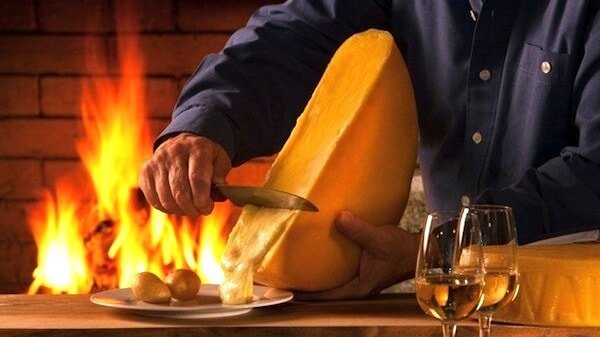
If you don’t know your Birchermüesli from your Bundnerfleisch this is where to start. The second of our culinary mountain guides, complete with recipes you can create yourself at home between the seasons, will help you imagine you are sitting in a mountain restaurant surrounded by snow outside.
This week: Switzerland
With thanks to the Swiss National Tourist Board for their help in compiling their list of favourite Swiss cooking – along with recipes.
Birchermüesli
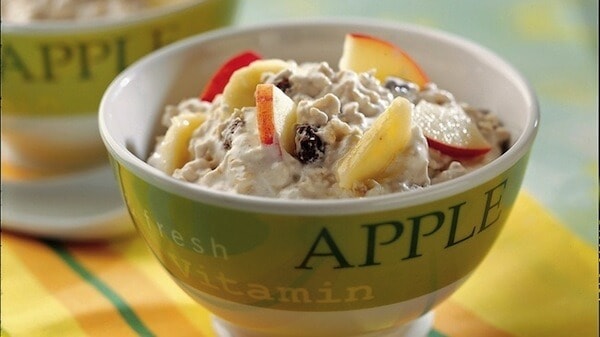
Europe’s favourite healthy breakfast was developed by Swiss Dr Max Bircher-Brenner. Just after he’d graduated from Zurich University in the early 1890s he opened a general practice in Zurich’s industrial quarter. The good doktor promptly fell ill with jaundice, but cured himself by eating fruit in general and apples in particular. An apple a day keeps the doctor away – or at least alive. He prescribed his version of the five-a-day to his patients and the non-heart attack brekky was born.
Preparation time: approximately 15 minutes
Soaking time: approximately 12 hours
Ingredients
40g oatmeal (oat flakes)
20g sultanas
1dl milk
180g organic yoghurt
2 bananas, cut lengthwise in 5mm thick slices
2 apples, remove cores and cut in 3mm thick slices
1.8dl whipped double cream
Method
Mix oats with sultanas and milk in a bowl. Cover and soak for
about 12 hours. Mix yogurt, bananas and apples with oat flakes and sultanas. Fold in whipped cream.
Cheese Fondue
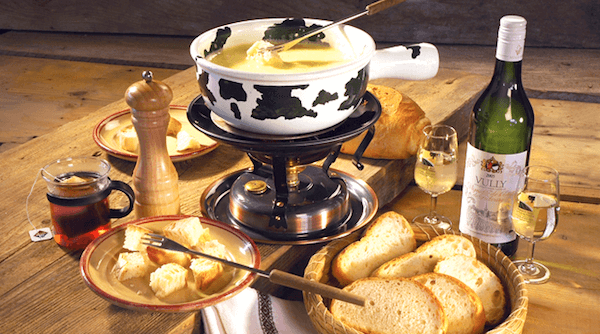
Up in the huts on the summer pastures and down in the village behind windows closely shuttered against the onslaught of winter…the fondue was born. This was the core recipe for mountain folk for using up old bits of cheese and stale crusts of bread. The bread cubes are picked up on the fork and swivelled in the melted cheese, which is served in a traditional ceramic fondue pot called a caquelon with a flame beneath it.
Ingredients (serves 4)
600g of preferably stale white bread cut into cubes. Crust is important and yesterday’s baguette is ideal.
300g fresh Gruyère cheese
300g of grated Vacherin cheese.
3dl dry white wine
1tbsp corn starch stir, add to the cheese and cook on low heat, stirring constantly
1 clove garlic, peeled and whole
2–3tbsp Kirsch
freshly ground pepper
paprika and nutmeg
Method
Melt both cheeses in the fondue pot. Add the wine and the rest of the ingredients and cook on a low heat, stirring constantly. Transfer the pot to the burner on the table. Continue to gently cook the fondue and dip in the bread.
Tips
If you use other cheese mixtures, shortly before serving add approximately 50g of Freiburg Vacherin; this will make the fondue thicker. Cheese, which has been stored for some time is usually better. During the meal, add a little white wine so that the mixture remains viscous. Some people like to mix a raw egg into the crust after most of the cheese has been eaten.
Käseschnitte/Croute au Fromage
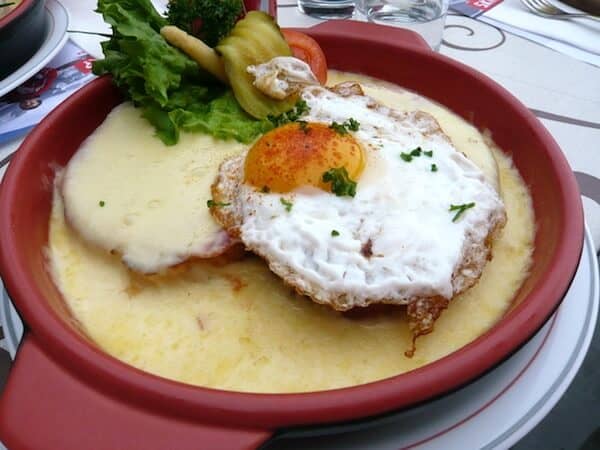
This is a Swiss version of cheese on toast that originally comes from the Valais, but you’ll find it all over Switzerland and in some French resorts close to the Swiss border. In the German-speaking part of the country, correct pronunciation by foreigners is important. For 20 years a colleague of ours wondered why the waitress always burst into laughter when he ordered the dish. He was asking for Kaiserschnitte rather than Kaseschnitte…not a cheese dish, but the German word for a Caesarian.
Preparation time: approximately 10 minutes
Baking time: approximately 15 minutes
Ingredients (makes 12 rarebits)
300g cheese (e.g. Emmentaler or Appenzeller), grated
1 egg, beaten
3 tbsp white wine or cider
1 pear or apple, peeled and grated
freshly ground pepper
1 baguette or other bread, cut diagonally into 1cm slices
Method
Thoroughly mix all ingredients. Spread the mixture on the bread and place on a baking sheet lined
with greaseproof paper. Bake for about 15 minutes at 220 C in the centre of a preheated oven. You can add a fried egg on top.
Pizzoccheri
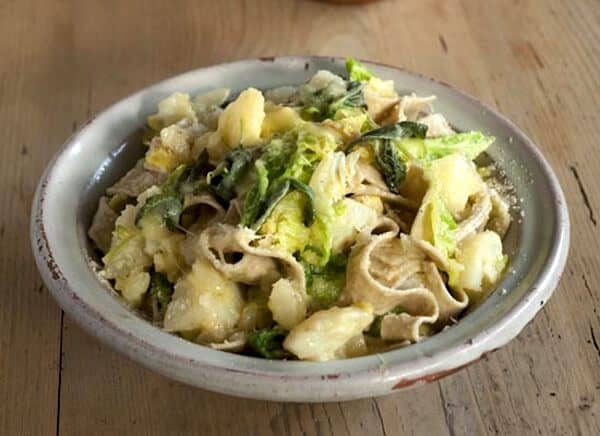
A pasta bake made with buckwheat pasta, vegetables and…you’ve guessed correctly…cheese.
Ingredients for the pasta dough
200g buckwheat flour
100g white flour
1tsp salt
Mix well in a bowl
1 egg
1dl water
1tsp oil
Beat with a fork, pour over flour, mix until dough is soft, knead until smooth, moisten the surface with a little water, cover and store at room temperature for 30 minutes.
Shaping
Roll out a 2mm thick dough on a floured board; cut into 5–6cm long and 1cm wide pieces
Pizzoccheri baking ingredients
Approximately 4 litres salted water
1tbsp oil
200g fresh, tender beans
200g potatoes, cut into 1cm thick slices.
Method
Place vegetables in the boiling water, cook 5 minutes, then add the Pizzoccheri. Shake off flour if necessary; cook for another 5 minutes (cooking time for Pizzoccheri is 8–10 minutes)
100g fresh peas
250g spinach leaves, add then cook for 3 minutes
100g half-fat mountain cheese, grated or in thin slices
100g Parmesan cheese, grated
Layer with Pizzoccheri and vegetables in a greased oven-proof dish
1tbsp oil heat in a frying pan
2 onions, cut in rings
2 cloves of garlic, sliced
a few sage leaves, fried lightly
50g melted butter for pouring over the dish
Bake in preheated oven for 5–10 minutes at 250 C. The cheese must melt.
Raclette
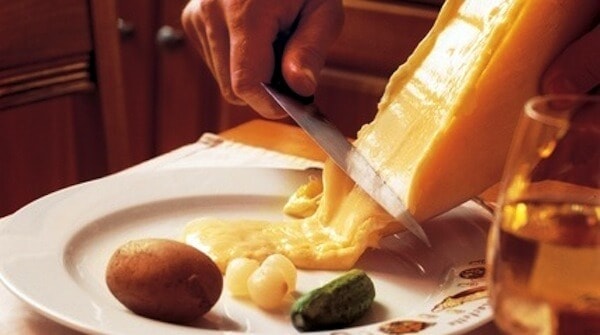
This is yet another way of cooking up the basic ingredients of the Swiss peasant mountain diet: cheese, air-dried meat, pickled onions and fruit, gherkins, and potatoes. Ideally you need a purpose-built raclette heater but you can improvise on a hob. In some mountain restaurants you find the cheese is melted in front of an open fire. However, melting your own cheese at the table is an essential part of the fun.
Ingredients (for 4 people)
8 small/medium Gschwellti (jacket potatoes), with skin left on
1.5lb Raclette cheese
Bündnerfleisch (dried beef), cut into paper-thin slices
1 jar pickled gherkin cucumbers (cornichons)
1 jar pickled onions
freshly ground pepper
paprika
Method
Wash potatoes and boil in a pot filled with salted water for about 20 minutes. Keep warm until ready to use in an insulated basket or bowl covered with silver foil. In the meantime remove the rind of the cheese and cut into approximately 1.5mm thick slices. You can get this slicked in your local supermarket or use a wire cheeser cutter at home. Arrange gherkins, onions, and meat on a platter and set aside until required. Turn raclette machine on until it begins to heat up (allow at least 5 minutes before using).
Each guest places a slice of cheese in their individual pan and slides it under the raclette grill to melt. It takes approximately 2 minutes to melt to a creamy consistency and 3 minutes for a crispier top. In the meantime take a potato, place onto your plate and cut it into a few pieces, remove the pan from under the grill and hold the pan onto its side to scrape the cheese out, using a wooden spatula. Season to taste with freshly ground pepper and paprika.
Rösti
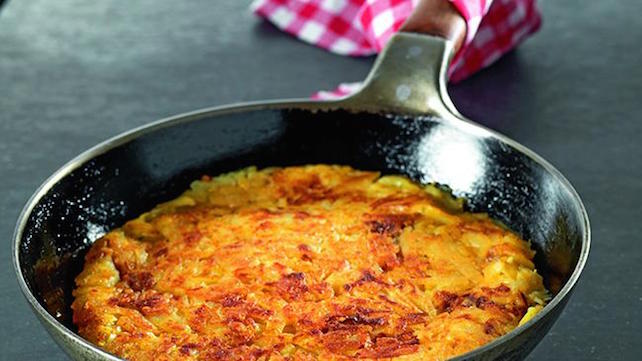
This is the iconic peasant dish of Switzerland that has spread in popularity across the world, a sort of Alpine hash browns with the simplest of ingredients.
The original idea was to find a tasty way of using up yesterday’s boiled potatoes by transforming them into a fried spud cake. However you can use parboiled potatoes or even raw potatoes, which can result in a lighter dish. Essentially Rösti is bound by nothing apart from the starch contained in the potatoes.
Ingredients
750g of waxy potatoes
1.5tsp salt
2tbsp butter or goose fat
2tbsp cold milk
Method
Parboil the potatoes in salted water the previous day and peel when still warm. Cool and sprinkle with the salt. Keep covered in the refrigerator then grate them coarsely. Alternatively use raw potatoes on the day of cooking.
Heat the butter in a frying pan, add the potatoes, turn and push with a spatula to form a cake. Spread milk over the potatoes and reduce heat. Cover the frying pan with a well-fitting lid or a large plate. Fry until a crisp brown crust has formed. Invert the Rösti cake on the lid or plate; slide the unbaked side of the cake into the frying pan. Bake uncovered for another 10 minutes. Slide it onto a platter or invert it with the help of the lid and place on the warmed plate. Don’t flip it – the cake will collapse. Fry until golden brown and serve – ideally with a fried egg on top.
If you’re interested in other Alpine cooking, see also our features on Austrian ski food, Norwegian cooking, The Secrets of Swiss Chalet Cooking, The Best Mountain Food, and Ski Nutrition.


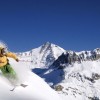

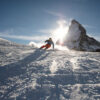







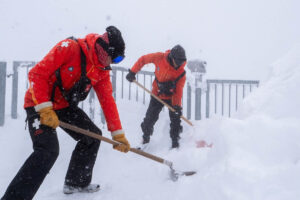

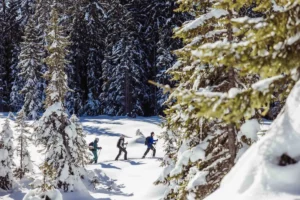
Add Comment